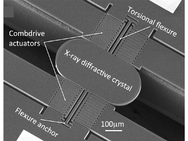
Using microelectromechanical systems (MEMS) technology, a new class of devices has been made by scientists in the Center for Nanoscale Materials (CNM) Nanofabrication & Devices Group and the Advanced Photon Source (APS) for controlling X-rays. MEMS allow shrinking the optics to the microscale creating ultrafast devices for reflecting X-rays at precise times and specific angles.
The successful application of the MEMS technology to manipulate an X-ray beam at very high frequencies will lead to more elaborate X-ray optical schemes for studying the structure and dynamics of matter at atomic length and time scales. CNM’s resources were utilized to design, fabricate and characterize the torsional MEMS device. APS was exploited for demonstrating this new technology using static and dynamic X-ray diffraction profile measurements.
MEMS are microscale devices fabricated using silicon wafers in facilities that make integrated circuits. The MEMS device acts as an ultrafast mirror reflecting X-rays at precise times and specific angles. The new device consists of a tiny diffracting mirror that oscillates at high speeds. As the mirror tilts rapidly back and forth, it creates an optical filter that selects only the X-ray pulses desired for the experiment. Only the light that is diffracted from the mirror goes on to hit the sample, and by adjusting the speed at which the MEMS mirror oscillates, researchers can control the timing of the X-ray pulses.
In the future, the MEMS devices could split an X-ray pulse into even tinier, faster, and more precise slices by oscillating the device many millions of times a second, according to Argonne emeritus scientist Gopal Shenoy, a co-author of the study. “It will herald a new era of dramatically new and improved kinds of X-ray experiments,” he said.
“The advantage of this new device is that it provides a very cheap way to generate and manipulate X-rays, and it can be adapted to virtually any X-ray facility in the world that already exists,” said CNM’s Daniel Lopez, the lead author of the study.
Mukhopadhyay, D.A. Walko, I.W. Jung, C.P. Schwartz, J. Wang, D. Lopez, and G.K. Shenoy, “X-ray photonic microsystems for the manipulation of synchrotron light,” Nature Communications 6:7057 doi: 10.1038/ncomms8057 (2015).
